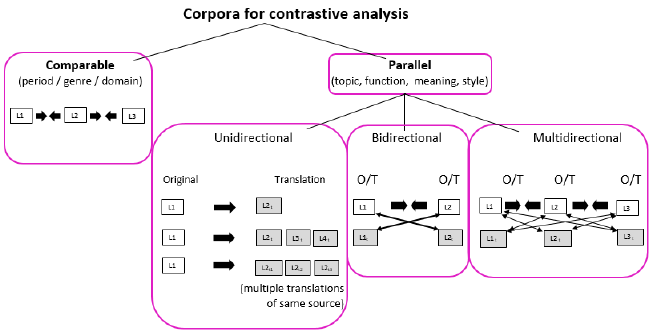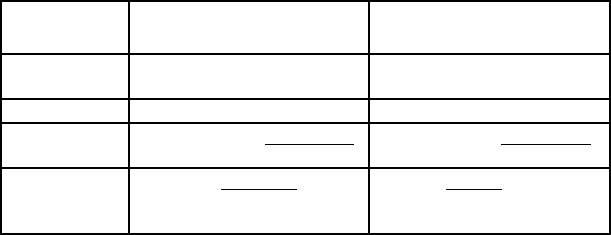
Oksefjell Ebeling, Signe and Jarle Ebeling. 2020. “Contrastive Analysis,
Tertium Comparationis and Corpora.” Nordic Journal of English Studies
19(1):97-117.
Contrastive Analysis, Tertium Comparationis and
Corpora
Signe Oksefjell Ebeling and Jarle Ebeling, University of Oslo
Abstract
This paper highlights the importance of a common ground, or tertium comparationis, in
order to establish unbiased cross-linguistic equivalence in contrastive studies. Following
an outline of the two main types of corpora used in contrastive analysis—comparable and
parallel bidirectional—a discussion of how they relate to different tertia comparationis is
presented. This is further illustrated in a case study where the same phenomenon is
investigated based on the two types of corpora. It is concluded that a bidirectional parallel
corpus, relying on both comparable monolingual and bidirectional translation data, may
yield more robust insights into cross-linguistic matters than either of the two on their
own.
Keywords: contrastive analysis; tertium comparationis; comparable corpora; parallel
corpora; English; Norwegian; for NPgen sake
1. Introduction
This paper addresses one of the main challenges within the field of
contrastive lingusitics, namely equivalence, through a direct comparison
of two types of tertia comparationis. It is generally agreed that in order
to establish equivalence across languages, a sound tertium comparationis
is needed, i.e. an objective background of sameness that ensures that we
compare like with like. Several tertia comparationis have been launched
over the years, including surface form, deep structure and translation, but
no consensus has been reached (see e.g. James 1980; Ebeling & Ebeling
2013a). That form, or surface structure, alone is a poor basis for
comparison if the aim is to study meaning and/or function is
acknowledged by Biber (1995) in a contrastive study of relative
constructions, where he notes that “despite the obvious structural
similarities between relative constructions in Somali and English, the
distribution of these features indicates that they are serving very different
functions in the two languages” (Biber 1995: 75).
Within corpus-based contrastive analysis, the types of available
tertia comparationis are very much tied to the different types of corpora

Signe Oksefjell Ebeling and Jarle Ebeling
98
that are typically used in cross-linguistic research, i.e. comparable
corpora and parallel corpora of different kinds (e.g. uni-, bi- or
multidirectional). Johansson (2011) strongly believes in the advantages
of using parallel as opposed to comparable corpora:
The special advantage of parallel corpora is that they contain texts which are
intended to express the same meanings and have the same discourse functions in the
relevant languages. Using the source or the target language as a starting-point, we
can establish paradigms of correspondences. […] The most difficult problem in
using comparable corpora is knowing what to compare, i.e. relating forms which
have similar meanings and pragmatic functions. (Johansson 2011:126–127)
Arguments against using translations as the (only) tertium comparationis
in cross-linguistic studies come, in particular, from scholars who see
translations as a ‘third code’ (Frawley 1984), and who claim that
translations will deviate from the source text to a considerebale degree,
making them unsuitable as an empirical basis. Teubert (1996), for
instance, says that “[t]ranslations, however good and near-perfect they
may be (but rarely are) cannot but give a distorted picture of the
language they present” (1996: 247).
Against this backdrop, we will conduct the same study based on the
two types of corpora (comparable and parallel) representing different
tertia comparationis. To our knowledge no study has hitherto
systematically carried out the same study on the basis of comparable vs.
bidirectional parallel corpora and juxtaposed the analysis in the way done
here. We hope to be able to demonstrate the impact the type of corpus
might have regarding insights gained about cross-linguistic equivalence.
We start with a brief outline of modern contrastive analysis (CA) as
a systematic research paradigm in Section 2. Section 3 discusses
different kinds of contrastive corpora, how they relate to different tertia
comparationis and thus may have an impact on how equivalence in CA
is tackled. Also in Section 3, an overview of the pros and cons of such
“contrastive” corpora is presented. Section 4 introduces the English-
Norwegian contrastive case study that is used as a testbed for carrying
out the same study on the basis of a comparable vs. a bidirectional
parallel corpus, demonstrating two different tertia comparationis: similar
forms and translation (Sections 5 and 6, respectively). Some concluding
remarks are offered in Section 7.

Contrastive Analysis, Tertium Comparationis, Corpora
99
2. Modern Contrastive Analysis
In this section, we offer a brief discussion of a select few approaches
within modern contrastive analysis (CA). It would be impossible to
describe and discuss the many ways in which to conduct a CA that have
been proposed over the past 60 years or so in this short article. We refer
the interested reader to some important works, and references therein, for
more comprehensive and detailed accounts: Aijmer et al. (1996),
Altenberg & Granger (2002), Johansson (2007), Hasselgård (2010),
Ebeling & Ebeling (2013a) and Mair (2018) and articles published in the
journal Languages in Contrast (John Benjamins).
A much-used approach in CA is to take a perceived similarity, or
dissimilarity, between the languages to be compared as the point of
departure, be it at the level of lexis, syntax or semantics (meaning).
Based on the perceived similarity a null hypothesis, e.g. that the
items/phenomena to be compared are equivalent, can be formed and
tested. Chesterman (1998) advocates such an approach and recommends
the following steps, where the starting point, and first step, is a
(dis)similarity of any kind between phenomenon X in language A and
phenomenon Y in language B. A phenomenon can in principle be almost
anything: a situation, a gesture, a construction, a category or an item.
Based on the similarity, the following question is posed (step 2): what is
the nature of the similarity (form, meaning, function)? The third step
involves the description of the relationship between X and Y in the
compared languages, or as is more often the case, the relationship
between X in language A and Y1, Y2, Y3, etc. in language B (see e.g.
Dyvik (1998) and his semantic mirrors). Based on the outcome of step 3,
the null hypothesis can be corroborated or rejected. The resulting
description can also be used to enrich our knowledge of the individual
languages and/or the relationship between the languages compared, at
e.g. the formal, semantic and/or functional levels.
In addition to the rigorous method suggested by Chesterman, there
are other, more exploratory ways into a contrastive study. One fruitful
point of departure is any observed quantitative difference between
original and translated texts of the same type and size (e.g. Johansson
2007: Ch. 4). Yet another approach is to register zero correspondences in
a parallel corpus (e.g. Ebeling & Ebeling 2013b), that is where an item in
one language does not seem to have a (direct) correspondence in the
other language, and ask what the reasons for these non-correspondences

Signe Oksefjell Ebeling and Jarle Ebeling
100
may be. One could also start more opportunistically by choosing a word,
frame, pattern or construction in language A and record and analyse all
the corresponding items/units in language B, i.e. create a list of
translation paradigms, to describe similarities and differences at the
levels of, for instance, syntax and/or semantics (e.g. Johansson 2001 on
seem and its Norwegian correspondences). In all of these cases, close,
qualitative scrutiny of the differences should be part of the study. Note
that several of the more exploratory approaches require access to a
corpus of original texts and aligned translations.
To end this short description of ways of doing CA, we quote
Johansson (2012: 46) and what he calls “contrastive linguistics in a new
key”, i.e. contrastive analysis in which
• the focus on immediate applications is toned down;
• the contrastive study is text-based rather than a comparison
of systems in the abstract;
• the study draws on electronic corpora and the use of
computational tools.
The list sets modern CA apart from early (pre-corpora) CA where the
focus was on applied aims and applications, e.g. error analysis of
learners’ mistakes and on (intuitive) claims about differences between
languages or simply by comparing language systems, as found in e.g.
monolingual grammar books (see James 1980; Mair 2018).
By modern corpus-based contrastive analysis we understand research
which is grounded in empirical (corpus) data in two or more languages,
with the challenges and limitations that this entails, for instance with
regard to the type and amount of data available. This is in fact one of the
main challenges of modern contrastive research. We now turn to these
challenges in a comparison of comparable and parallel corpora.
3. Types of Corpora Used in Contrastive Analysis
There is a clear difference between comparable and parallel corpora. The
former are usually matched by period, genre and/or domain to enable the
contrastive analysis, while the latter consist of original and translated
texts in two or more languages, and are, in this way, also matched by

Contrastive Analysis, Tertium Comparationis, Corpora
101
topic, function, meaning and style. Figure 1 presents an overview of
these two main types of corpora.
Figure 1. Corpora used in CA (inspired by Aijmer 2008; Johansson 2007; McEnery &
Xiao 2007)
As shown in Figure 1, in a comparable corpus, original texts in two or
more languages—L1, L2, L3 etc.—can be compared to each other,
pairwise (L1 vs. L2; L1 vs. L3; L2 vs. L3) or one can compare L1 vs. L2
& L3, L2 vs. L1 & L3, etc.
When it comes to parallel corpora, these can be further sub-divided
into unidirectional, bidirectional and multidirectional with an increasing
complexity of correspondences: from the simplest unidirectional corpus
between two languages (from Language 1 → Language 2
T
) to the most
complex multidirectional one between several languages, e.g. L1, L2 and
L3 with translations into the other languages (L1 → L2
T
; L1 → L3
T
; L2
→ L1
T
; L2 → L1
T
; L3 → L1
T
; L3 → L2
T
). In addition, the structure of
bidirectional and multilingual corpora enables comparisons of the
comparable type as well as comparisons of features of translation within
and across languages.
Corpus-based contrastive research between English and Norwegian
and between English and Swedish has often been conducted on the basis

Signe Oksefjell Ebeling and Jarle Ebeling
102
of a balanced, bidirectional, parallel corpus,
1
since, in addition to being
comparable, such a corpus gives the researchers the possibility of starting
the analysis in either language and in either original or translated texts
and, more importantly, to control for translation effects and source
language shining through (Johansson 2007; Teich 2003).
2
Before we present the case study, it is useful to keep the pros and
cons of the main types of contrastive corpora in mind. These are outlined
in Table 1, which is inspired by Altenberg & Granger (2002), Johansson
(2007), Aijmer (2008), Ebeling & Ebeling (2013a), and an adapted
version of Hasselgård (Forthc.)
Table 1. The pros and cons of corpus types for CA
Pros
Cons
Comparable corpora
• Not restricted to
translated text types
• More readily
available
• Comparison of
original language
• Criteria for
comparability (TC)?
• No alignment possible
• Cannot reveal sets of
cross-linguistic
correspondences
Parallel
corpora
Unidirectional
translation corpora
• Alignment is
possible
• Meaning and
function constant
across the
languages (a
relatively sound
TC is present)
• Possible to discover
(sets of) cross-
linguistic
correspondences
(‘translation
paradigms’)
• Restricted range of text
types
• Translation effects:
o Traces of source
language in translated
texts
o Traces of the
translation process,
including errors
1
See e.g. the bibliography of publications based on the English-Norwegian
Parallel Corpus and the English-Swedish Parallel Corpus:
https://www.hf.uio.no/ilos/tjenester/kunnskap/sprak/omc/enpc_espc_publication
s_2014.pdf
2
Translation effect has also been termed ‘translationese’ See e.g. Gellerstam
(1986) and Volansky et al. (2013).

Contrastive Analysis, Tertium Comparationis, Corpora
103
Balanced, bi-
/multidirectional
translation corpora
• Same as
unidirectional
translation copora
PLUS:
o Possible to check
translations in
both directions
(control for
translation
effects)
o Comparison of
original language
o A sounder TC is
present
• Even more restricted
range of text types
• Achieving balance of
text types between
directions of translations
Comparable corpora have one huge advantage over parallel corpora, and
that is that they are not restricted to text types that are translated. It is, for
instance, nearly impossible to find English translations of scientific texts
originally written in a Scandinavian language, since researchers and
scientists in the Scandinavian countries generally write in English.
One of the main challenges with comparable corpora is that the texts
in the different languages are not directly and explicitly linked to each
other linguistically. This means that it is hard to establish a sound and
objective tertium comparationis, since one cannot be absolutely sure that
one compares like with like. Even though the types of texts in the
languages compared represent a common ground suitable for
comparison, the actual items compared may not have been selected on
the basis of a tertium comparationis that fulfills all levels of linguistic
comparability: form, function and meaning. To some extent one may
compensate for this by using one’s bilingual knowledge or a dictionary.
Parallel corpora have the advantage that they can be aligned at
sentence level, thus making it relatively easy to recognise corresponding
items in original and translation, that is, a sound common ground on
which to build a direct comparison is present. This common ground has
been claimed to become even firmer and more objective if you have a bi-
or multidirectional parallel corpus, which is also in effect a comparable
corpus in that it contains original language data in all the languages
compared (cf. Johansson & Hofland 1994; Johansson 2007; Aijmer
2008).
We now turn to the case study where we will perform an analysis of
the same phenomenon in the two different types of corpora.

Signe Oksefjell Ebeling and Jarle Ebeling
104
4. Case Study: Background
The case study takes a previous contrastive investigation as its starting
point. Ebeling & Ebeling (2014) present a corpus-based contrastive
analysis of two similar-looking patterns in English and Norwegian,
namely for * sake and for * skyld, where the asterisk stands for a genitive
noun.
3
The present study is in many ways an experiment in the sense that an
attempt will be made to carve up the original study in a different way.
The purpose of the experiment is to demonstrate and put focus on the
pros and cons of two different tertia comparationis (TC) in contrastive
analysis. The first TC is based on sameness of form and draws on corpus
data from a comparable corpus of English and Norwegian, while the
second is based on (sameness of form and) translation data from a
bidirectional parallel corpus of English and Norwegian. The former will
be referred to as “the comparable study” (Section 5) and the latter as “the
bidirectional parallel study” (Section 6).
The corpus used for the occasion is the English-Norwegian Parallel
Corpus+ (ENPC+) (Ebeling & Ebeling 2013a), which is structured
according to Johansson’s parallel corpus model; thus it contains both
comparable and bidirectional translation data in one (Johansson &
Hofland 1994). The ENPC+ is an extended version of the fiction part of
the English-Norwegian Parallel Corpus (ibid.) and contains around 1.3
million running words of contemporary English and Norwegian fiction
texts and their respective translations into the other language.
4
In other
words, it is a balanced corpus amounting to rougly 5.2 million words in
total.
The comparable version of the study is based on material drawn from
the texts originally written in English and Norwegian only, while
material from both originals and translations will be explored in the
bidirectional parallel study.
3
There are exceptions to this in Norwegian, where no genitive marking of the
noun is found, e.g. for moro skyld (ʻfor fun sakeʼ). Moreover, the Oxford
English Dictionary notes that “[t]he omission of the ʼs is now obsolete, but it is
still not uncommon to write for conscience sake, for goodness sake, for
righteousness sake, etcˮ. However, no such instances were attested in our
material.
4
These include extracts of 10,000-15,000 words from 30 texts and nine full-text
novels.

Contrastive Analysis, Tertium Comparationis, Corpora
105
4.1 Preliminary Observations of the Patterns
Ebeling & Ebeling (2014: 192) start by outlining the meanings of the for
* sake pattern according to Oxford Dictionaries Online (now
Lexico.com): (a) for the purpose of, (b) out of consideration for or in
order to help or please someone, and (c) to express impatience,
annoyance, urgency, or desperation. It is argued that the Norwegian
pattern incorporates the same meanings, as attested in examples (1)–(3)
from Norwegian original texts with their translations into English.
(a) For the purpose of something
(1) For sikkerhets skyld ber jeg ham tie om at vi har en kopi.
(ToEg1N)
5
For safetyʼs sake, I ask him not to tell anyone that we have a copy.
(ToEg1TE)
(b) Out of consideration for or in order to help or please someone
(2) En gang sa hun at hun gjorde det for pappas skyld og for oss, så vi
hadde penger nok. (PeRy1N)
Once she said that she was doing it for Dadʼs sake, so that we
would have enough money. (PeRy1TE)
(c) To express impatience, annoyance, urgency, or desperation
(expletive use)
(3) Si noe, for Guds skyld! (LSC2)
6
Say something, for Godʼs sake! (LSC2T)
The examples serve to illustrate that, based on dictionary definitions,
bilingual competence and examples from translations, there is indeed a
perceived similarity between the two patterns, not only in terms of form,
but also in terms of meaning.
5
The corpus text code identifies the author of the text (ToEg = Tom Egeland),
text number by that author (1) and language (N). The code of the English
translation of this text is ToEg1TE. See Ebeling & Ebeling (2013a) for an
overview of texts and text codes included in the ENPC+.
6
In texts from the original ENPC, language is not specified in the corpus text
code, thus LSC2 (and not LSC2N).

Signe Oksefjell Ebeling and Jarle Ebeling
106
5. Comparable Version of the Study
We start by investigating the patterns on the basis of the comparable part
of the ENPC+, i.e. the use of for * sake in English originals vs. for *
skyld in the Norwegian originals. Following an analysis of the respective
concordance lines in these texts, our first observation is that all three
uses/meanings are attested in the original texts in both languages, e.g.
examples (4)–(9).
(a) For the purpose of something
(4) We stayed together for appearances’ sake, … (PeRo2E)
(5) … det videre søket etter Leike ville bare være for syns skyld.
(JoNe2N)
(b) Out of consideration for or in order to help or please someone
(6) Just for a while, then, another chapter or two — for Miriam’s sake.
(PaAu1E)
(7) … men for Mathias’ skyld, herregud, de hadde jo et barn sammen!
(JoNe1N)
(c) To express impatience, annoyance, urgency, or desperation
(expletive use)
(8) For God’s sake, stop! (MiWa1E)
(9) — Pass opp, for Guds skyld, ropte vi. (PePe1N)
When each instance of the patterns is classified according to meaning,
striking cross-linguistic differences become apparent. As shown in Table
2, the preferred use is very different in the two languages: expletive is by
far the most common use in English and the purpose use is the most
common use in Norwegian.
Table 2. Distribution in the original texts according to meaning (Ebeling
& Ebeling 2014: 201)
Meaning
for * sake
EO
for * skyld
NO
Purpose
3
3.5%
47
73.4%
Consideration
17
20.0%
12
18.8%
Expletive
65
76.5%
5
7.8%
Total
85
64

Contrastive Analysis, Tertium Comparationis, Corpora
107
The difference can be summed up as follows, in terms of preferred use in
the two languages:
• English: Expletive>Consideration>Purpose
• Norwegian: Purpose>Consideration>Expletive
An almost symmetrically opposite use is thus noted for expletive and
purpose for * sake and for * skyld, with the consideration use nicely
placed in the middle and used with proportionally very similar
frequencies in the two languages (20% vs. 18.8%).
Further cross-linguistic (comparable) analysis reveals additional
differences in the use of the English and Norwegian patterns. These can
be summarized according to Sinclairʼs (1996, 1998) extended-units-of-
meaning (EUofM) model, in which the English and Norwegian patterns
can be said to operate as cores of two different EUofM. To elaborate: the
immediate context of the English and Norwegian patterns (cores),
studied through concordance lines, clearly show that, although they both
colligate with a noun in the genitive, they typically take different
collocations, have a different semantic preference, and ultimately a
different semantic prosody. The semantic prosody of the unit with the
English core for * sake is to express annoyance, bordering on the
negative, while Norwegian for * skyld is part of a more neutral unit
expressing purpose.
In the light of this analsyis, we can conlude that a comparable study
of the two patterns offers valuable cross-linguistic insights along the
lines outlined in Figure 2.
English
(Core: for * sake)
Norwegian
(Core: for * skyld)
Collocation
for [God’s / Christ’s / fuck’s]
sake
for [sikkerhets / syns / ordens]
skyld
Colligation
for NPgen sake
for NPgen skyld
Semantic
preference
words to do with religion, sex
words to do with arrangement
(order, safety, simplicity)
Semantic
prosody
(Negative) annoyance (in the
form of swearing or near-
swearing)
(Neutral) purpose (typically for
the purpose of safety)
Figure 2. for * sake and for * skyld as cores of different EUofM

Signe Oksefjell Ebeling and Jarle Ebeling
108
The comparable analysis raises a set of pertinent questions: how similar
are these two patterns? Have we compared like with like? And to make
sure we do that, how can we best capture expressions that are similar in
meaning to the for * sake or for *skyld patterns in the other language?
For example: How is the expletive use typically expressed in Norwegian
if not by the formally similar pattern?
To investigate this, we turn to the bidirectional parallel version of
this study, to see what insights this may yield in addition to what we
have now learnt from the comparable part of the study.
6. Bidirectional Version of the Study
The first step in this part of the analysis is to give an overview of the
number of occurrences of the English and Norwegian patterns in the
original texts and to what degree they correspond to each other in
translation. In other words, we are concerned with congruent and non-
congruent correspondences of the patterns, where congruent means
formally similar and non-congruent formally dissimilar (Johansson 2007;
Ebeling & Ebeling 2013a). Table 3 offers a simplified overview of such
correspondences of the patterns in the bidirectional parallel material.
Table 3. Translations of for * sake and for * skyld in the ENPC+ (raw
numbers)
Correspondence
EO > NT
NO > ET
Congruent for * sake = for * skyld
27
18
Non-congruent for * sake/skyld = ‘other’
58
46
Total
85
64
Not surprisingly, based on what has already been shown, the
correspondence in translation between the two patterns is far from 100%.
Going from English into Norwegian (EO > NT): for *sake is translated
congruently into for * skyld in 27 out of the 85 cases, and from
Norwegian into English (NO > ET) in 18 out of 64. Following Altenberg
(1999), this gives a mutual correspondence of only around 30% for the
patterns, i.e. they are only used to translate each other in about 30% of
the cases. Although it is rare to find items with a mutual correspondence
of 100%, such a low cross-linguistic correspondence rate as the one
established for for *sake and for * skyld suggests that the two patterns
have very different conditions of use in their respective languages, thus
Contrastive Analysis, Tertium Comparationis, Corpora
109
adding strength to the conclusions arrived at in the comparable analysis
in Section 5.
The low mutual correspondence begs the question of what actually
happens in the translation of the patterns, not least in the non-congruent
cases. Examples (10)–(12) show the main tendencies for the English
pattern.
English expletive → non-congruent
(10) “They’re just traffic cones, for fuck’s sake.” (PeRo2E)
“Det er jo bare trafikkjegler, for faen.” (PeRo2TN)
Lit.: … for the devil
English consideration → congruent
(11) For my sake. (JB1)
For min skyld. (JB1T)
English purpose → congruent
(12) We stayed together for appearances’ sake … (PeRo2E)
Vi holdt sammen for syns skyld … (PeRo2TN)
Typically, then, the main use in English—the expletive use—is
translated by a non-congruent correspondence in Norwegian, in 54 out of
the 65 cases (see Table 2), as in (10), possibly because this is the least
favoured use of the Norwegian pattern. Both the consideration use in
(11) and the purpose use in (12) represent more natural and idiomatic
uses in Norwegian, and the few cases, are rendered congruently, in 13
out of 17 cases for the consideration use and in three out of three cases
for the purpose use (see Table 2).
Similarly, in the other direction of translation—from Norwegian into
English—the few instances of the expletive use in Norwegian typically
get a congruent expletive translation in English (four out of five), as in
(13). This is also the case for the consideration use in (14), in eight out of
12 cases, whereas the favoured use in Norwegian, purpose, typically gets
a non-congruent correspondence in English (in 41 out of 47 cases; see
Table 2), as shown in (15).
Signe Oksefjell Ebeling and Jarle Ebeling
110
Norwegian expletive → congruent
(13) - Slipp han nå for guds skyld ned. (PePe1N)
“Put him down, for God’s sake.” (PePe1TE)
Norwegian consideration → congruent
(14) … hun gjorde det for pappas skyld … (PeRy1N)
… she was doing it for Dad’s sake … (PeRy1TE)
Norwegian purpose → non-congruent
(15) Han rygget et skritt for sikkerhets skyld. (KaFo1N)
Lit.: … for safety’s sake
He retreated a step, just to be on the safe side. (KaFo1TE)
The tendencies reported in both directions of translation corroborate, and
add more confidence to, the findings from the comparable (part of the)
study with regard to preferred meanings and uses: expletive in English
and purpose in Norwegian. In addition, the bidirectional study provides
non-congruent correspondences in both directions of translation showing
by which means (forms) the expletive use is rendered in Norwegian and
the purpose use in English. Thus, a more robust contrastive analysis is
achieved.
In the following, we will look in more detail at the non-congruent
correspondences of the two uses that differ the most. We start with the
purpose use in Norwegian before moving on the the expletive use in
English in order to see how these uses are expressed in the other
language in terms of non-congruent correspondences, both as translations
and as sources.
The most frequent purpose expressions in the Norwegian data are for
sikkerhets skyld ‘for safety’s sake’ and for moro skyld ‘for fun sake’, and
Table 4 shows the two correspondence patterns that are clearly preferred
to express the former of these in English (to be on the safe side and just
in case). Another pattern is clearly preferred to express the latter, namely
for + Noun, as in for fun, for pleasure etc.). The ‘other’ expressions
referred to in Table 4 are not tied to specific nouns in the open slot in
Norwegian, but quite a few of the English correspondences have the
fixed expressions a matter of and for the sake of followed by a noun.

Contrastive Analysis, Tertium Comparationis, Corpora
111
Table 4. The most salient non-congruent English correspondences
(translations and sources) of the most frequent Norwegian purpose uses
with for * skyld
for sikkerhets skyld (‘for
safety’s sake’)
for moro skyld (‘for fun’s
sake’)
Other
to be on the safe side
just in case
for N (fun / entertainment
/ pleasure)
a matter of N
for the sake of N
As for the English expletive use, the three most frequent sequences in the
English texts are for Christ’s sake, for fuck’s sake and for God’s sake.
The most salient non-congruent Norwegian correspondences are listed in
Table 5.
Table 5. The most salient non-congruent Norwegian correspondences
(translations and sources) of the most frequent English expletives with for
* sake
for Christ’s sake
for fuck’s sake
for God’s sake
for svingende (lit. ‘for
swinging’)
for svingende (lit. ‘for
swinging’)
herregud (‘God’, lit.
‘lordgod’)
herregud (‘God’, lit.
‘lordgod’)
helvete (‘hell’)
(for) faen (‘(for) the
devil’)
(for) faen (‘(for) the
devil’)
i herrens navn (‘in the
lord’s name’)
It is interesting to note that there is some overlap in the Norwegian
correspondences of the three different English expletive patterns. Both
for Christ’s sake and for God’s sake have herregud ‘lordgod’ and the
rather strange expression for svingende ‘for swinging’. While the former
is an expletive within the same domain as Christ and God, for svingende
can, as pointed out in Ebeling & Ebeling (2014: 203), be considered a
pretend or quasi-swear word or nestenbanning (‘almost-swearing’) in
Hasund’s (2005) terms. For svingende is only found in the translations,
and it could be argued that the translators have tried to tone down the
Signe Oksefjell Ebeling and Jarle Ebeling
112
expletive, even if for Christ’s sake and for God’s sake are thought of as
fairly mild expletives.
The other overlap in the correspondences is arguably more curious,
as the two English expletives—one from the sexual domain (for fuck’s
sake) and one from the celestial (for God’s sake)—both are found to
correspond to the diabolical faen ‘the devil’. This is in fact the most
common Norwegian correspondence of the English expletive overall.
Of the two remaining, relatively common non-congruent
correspondences shown in Table 4, i herrens navn ‘in the lord’s name’
seems a more natural and unmarked correspondence of for God’s sake
than helvete ‘hell’ is of for Christ’s sake.
Although we can merely speculate at this stage, observations like
these may tell us something about a culture’s swearing preferences, with
English being, in this pattern at least, drawn towards the celestial and
sexual, while Norwegian is drawn either towards the diabolical or the
celestial (herregud, i herrens navn).
6.1 Summary of the Bidirectional Parallel Study
In addition to uncovering different preferences of use in English and
Norwegian (including different extended-units-of-meaning) on the basis
of both comparable and parallel data, we have been able to demonstrate
that access to, and analysis of, bidirectional translation data means that
we, through translation as TC, can offer corresponding, and arguably
more equivalent, expressions of the for * sake / for * skyld pattern in the
other language. For example, typical Norwegian expletives
corresponding to the expletive for * sake pattern emerged, and similarly,
other and more typical English expressions of purpose corresponding to
the purpose for * skyld pattern emerged. These can be further explored in
a more comprehensive contrastive study of swearing and the expression
of purpose between the two languages. In addition, highlighting the
importance of bidirectionality, the “soft” Norwegian correspondence of
the English expletive (for svingende) may be considered less equivalent
than the other correspondences since it was only attested in the translated
material. Moreover, the observation from the comparable study that the
patterns seem to be cross-linguistically most similar to each other in the
consideration use was not only confirmed on the basis of the
Contrastive Analysis, Tertium Comparationis, Corpora
113
bidirectional data, but further evidence was brought to the table through
the large proportion of congruent correspondences.
We believe that we gain a deeper understanding of the items
compared when using a bidirectional parallel technique as it offers a
more comprehensive contrastive account of the patterns compared. It
should also be mentioned that a bidirectional parallel study like this one
could, and perhaps even should, serve as a starting point for further
investigations that draw on much larger comparable monolingual
corpora.
7. Concluding Remarks
In this article we have outlined some of the main types of corpora used in
contrastive research and pointed out some of their strengths and
weaknesses. In general terms, these can be summarized as follows: To
investigate cross-linguistic correspondence and equivalence on the basis
of a comparable corpus, researchers typically take predefined items or
categories as their starting point, emerging from a perceived similarity
(or even dissimilarity in some cases) in two or more languages (e.g.
causative constructions). The CA in these cases may be based on the
researcher’s bilingual knowledge, dictionaries, grammars, and earlier
research of previously identified causative constructions.
Parallel bidirectional corpora, on the other hand, add the dimension
of having access to a pool of translators’ bilingual competence, and what
choices the translators make in similar linguistic situations. This enables
investigations of both predefined and undefined items through perceived
similarities or dissimilarities. Moreover, there is arguably more room for
purely exploratory studies when the contrastive analysis is based on
bidirectional translation data.
Following these general observations regarding different types of
corpora and the tertia comparationis they represent, an attempt was
made to directly compare the two different copus-based contrastive
methods by performing two versions of the “same” cross-linguistic
study. The rationale behind this exercise was to see to what extent it
would lend support to the view held by some contrastive linguists that
correspondence in translation is a good tertium comparationis if applied
to carefully structured bidirectional parallel corpora. It was found that a
bidirectional study arguably yielded more robust cross-linguistic results

Signe Oksefjell Ebeling and Jarle Ebeling
114
as it has the extra advantage of providing translation paradigms. The
bidirectionality of such corpora also ensures that the researcher can
control for translation effects, i.e. potential translation-specific features.
It should be stressed that the idea of using bidirectional data for
contrastive analysis is not our own. We are indebted to Stig Johansson, in
particular, for devising a corpus integrating comparable monolingual and
bilingual translation data within the same model, as first seen in the
English-Norwegian Parallel Corpus (ENPC) (Johansson & Hofland
1994). The structure of the ENPC clearly yields results that are arguably
superior to results obtained exclusively on the basis of comparable
data—at least if the aim is to gain insight into the full cross-linguistic
picture. As pointed out by Aijmer (2008: 208),
[i]t is difficult to see how any other method could give such a clear and detailed
picture of the relationship between the languages and contribute to the language-
specific description of the languages compared.
However, comparable corpora are indispensable in contrastive studies,
particularly when integrated within a bidirectional parallel set-up, but
also as providers of more extensive data sets. Indeed, in a recent
publication by Granger (2018: 183), a methodological framework termed
Contrastive Translation Analysis is introduced, where a “multi-corpus
empirical basis for corpus-based crosslinguistic studies” is called for. In
this framework, both comparable and parallel corpora have a place and,
in addition, learner corpora of the languages being compared (ibid. 190).
References
Aijmer, Karin. 2008. “Parallel corpora and comparable corpora.” Corpus
Linguistics. An International Handbook, Vol. 1. Eds. Anke Lüdeling
and Merja Kytö. Berlin / New York: Walter de Gruyter. 275–292.
Aijmer, Karin, Bengt Altenberg and Mats Johansson (eds). 1996.
Languages in Contrast. Papers from a Symposium on Text-based
Cross-linguistic Studies. Lund 4–5 March 1994. Lund: Lund
University Press.
Altenberg, Bengt. 1982. The Genitive v. the of-construction: A Study of
Syntactic Variation in 17th Century English. Lund: Gleerup.
Altenberg, Bengt. 1999. “Adverbial connectors in English and Swedish:
Semantic and lexical correspondences.” Out of Corpora. Studies in
Contrastive Analysis, Tertium Comparationis, Corpora
115
Honour of Stig Johansson, Eds. Hilde Hasselgård and Signe
Oksefjell. Amsterdam: John Benjamins. 249–268.
Altenberg, Bengt and Sylviane Granger. 2002. “Recent trends in cross-
linguistic lexical studies.” Lexis in Contrast. Corpus-based
Approaches. Eds. Bengt Altenberg and Sylviane Granger.
Amsterdam: John Benjamins. 3–48.
Biber, Douglas. 1995. Dimensions of Register Variation. Cambridge:
CUP.
Chesterman, Andrew. 1998. Contrastive Functional Analysis.
Amsterdam: John Benjamins.
Dyvik, Helge. 1998. “A translational basis for semantics.” Corpora and
Cross-linguistic Research: Theory, Method, and Case Studies. Eds.
Stig Johansson and Signe Oksefjell. Amsterdam/Atlanta: Rodopi.
51–86.
Ebeling, Jarle and Signe Oksefjell Ebeling. 2013a. Patterns in Contrast.
Amsterdam: John Benjamins.
Ebeling, Signe Oksefjell and Jarle Ebeling. 2013b. “From Babylon to
Bergen: On the usefulness of aligned texts.” Bergen Language and
Linguistics Studies (BeLLS) 3(1), 23–42.
Ebeling, Signe Oksefjell and Jarle Ebeling. 2014. “For Pete’s sake! A
corpus-based contrastive study of the English/Norwegian patterns
‘for * sake’/ ‘for * skyld’.” Languages in Contrast 14(2), 191–213.
Frawley, William. 1984. Translation. Literary, Linguistic &
Philosophical Perspectives. Newark: University of Delaware Press.
Gellerstam, Martin. 1986. “Translationese in Swedish novels translated
from English.” Translation Studies in Scandinavia. Eds. Lars Wollin
and Hans Lindquist. Lund: CWK Gleerup. 88–95.
Granger, Sylviane. 2018. “Tracking the third code. A cross-linguistic
corpus-driven approach to metadiscursive markers.” The Corpus
Linguistics Discourse. In Honour of Wolfgang Teubert. Eds. Anna
Čermáková and Michaela Mahlberg. Amsterdam: John Benjamins.
185–204.
Hasselgård, Hilde. 2010. “Contrastive analysis/contrastive linguistics.”
The Routledge Linguistics Encyclopedia. Ed. Kirsten Malmkjær.
London: Routledge. 98–101.
Hasselgård, Hilde. Forthc. “Corpus-based contrastive studies:
beginnings, developments and directions.” To appear in Languages
in Contrast 2020:2.

Signe Oksefjell Ebeling and Jarle Ebeling
116
Hasund, Ingrid Kristine. 2005. Fy Farao! Om nestenbanning og andre
kraftuttrykk. Oslo: Cappelen.
James, Carl. 1980. Contrastive Analysis. London: Longman.
Johansson, Stig. 2001. “The English verb seem and its correspondences
in Norwegian: What seems to be the problem?” A Wealth of English.
Studies in Honour of Göran Kjellmer, Ed. Karin Aijmer. Göteborg:
Acta Universitatis Gothoburgensis. 221–245.
Johansson, Stig. 2007. Seeing through Multilingual Corpora: On the Use
of Corpora in Contrastive Studies. Amsterdam: John Benjamins.
Johansson, Stig. 2011. “A multilingual outlook of corpora studies.”
Perspectives on Corpus Linguistics. Eds. Viana Vander, Sonia
Zyngier and Geoff Barnbrook. Amsterdam: John Benjamins. 115–
129.
Johansson, Stig. 2012. “Cross-linguistic perspectives.” English Corpus
Linguistics: Crossing Paths. Ed. Merja Kytö. Amsterdam: Rodopi.
45–68.
Johansson, Stig and Knut Hofland. 1994. “Towards an English-
Norwegian parallel corpus.” Creating and Using English Language
Corpora: Papers from the Fourteenth International Conference on
English Language Research on Computerized Corpora, Zurich 1993,
Eds. Udo Fries, Gunnel Tottie and Peter Schneider. Amsterdam:
Rodopi. 25–37.
Lexico.com. 2019. Powered by OUP.
Mair, Christian. 2018. “Contrastive analysis in linguistics.” Oxford
Bibliographies Online, https://www.oxfordbibliographies.com/. DOI:
10.1093/obo/9780199772810-0214.
McEnery, Tony and Richard Xiao. 2007. “Parallel and comparable
corpora: What is happening?” Incorporating Corpora. The Linguist
and the Translator. Eds. Gunilla M. Anderman and Margaret Rogers.
Clevedon: Multilingual Matters. 18–31.
Oxford English Dictionary (OED) Online. 2020. Oxford: OUP.
http://oed.com/.
Sinclair, John. 1996. “The search for units of meaning.” Textus IX: 75–
106.
Teich, Elke. 2003. Cross-Linguistic Variation in System and Text. A
Methodology for the Investigation of Translation and Comparable
Texts. Berlin: Mouton de Gruyter.
Contrastive Analysis, Tertium Comparationis, Corpora
117
Teubert, Wolfgang. 1996. “Comparable or parallel corpora?”
International Journal of Lexicography, 9(3), 238–264.
Volansky, Vered, Noam Ordan and Shuly Wintner. 2013 [online pub.].
“On the features of translationese.” Literary and Linguistic
Computing 30(1) 2015, 98–118. DOI: https://doi.org/10.1093/
llc/fqt03
